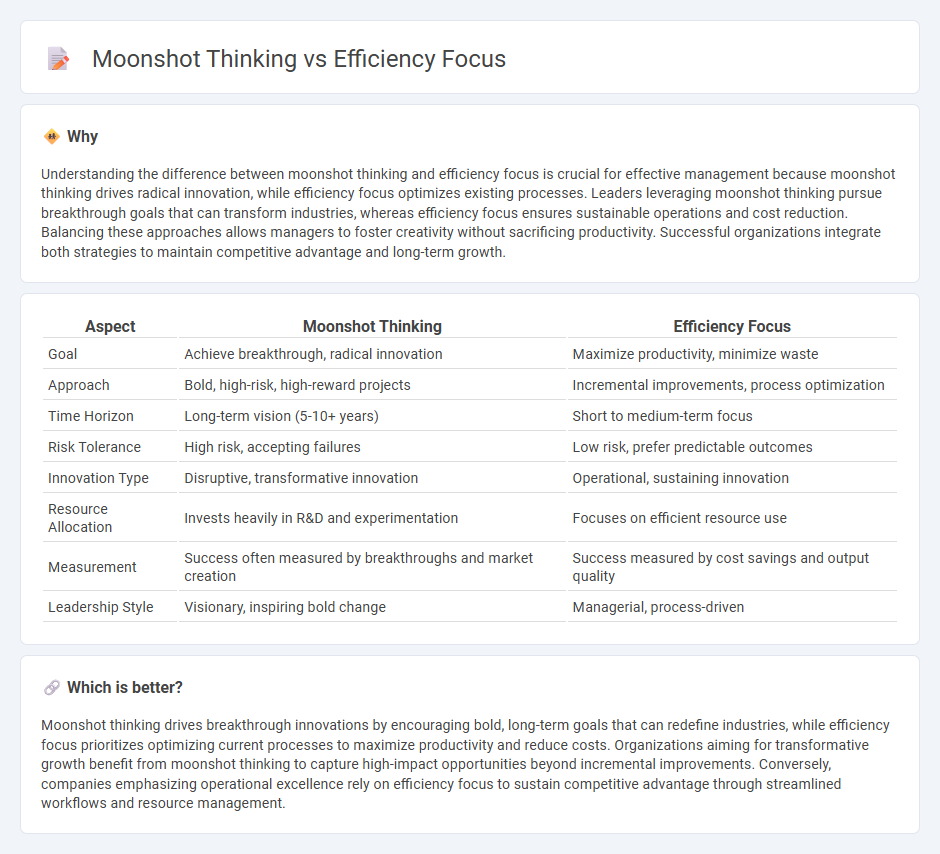
Moonshot thinking drives groundbreaking innovation by encouraging bold, long-term goals that redefine industries, while efficiency focus optimizes existing processes to maximize productivity and cost-effectiveness. Organizations balancing visionary moonshot projects with rigorous efficiency strategies can achieve sustainable growth and competitive advantage. Discover how integrating these management approaches transforms business outcomes.
Why it is important
Understanding the difference between moonshot thinking and efficiency focus is crucial for effective management because moonshot thinking drives radical innovation, while efficiency focus optimizes existing processes. Leaders leveraging moonshot thinking pursue breakthrough goals that can transform industries, whereas efficiency focus ensures sustainable operations and cost reduction. Balancing these approaches allows managers to foster creativity without sacrificing productivity. Successful organizations integrate both strategies to maintain competitive advantage and long-term growth.
Comparison Table
| Aspect | Moonshot Thinking | Efficiency Focus |
|---|---|---|
| Goal | Achieve breakthrough, radical innovation | Maximize productivity, minimize waste |
| Approach | Bold, high-risk, high-reward projects | Incremental improvements, process optimization |
| Time Horizon | Long-term vision (5-10+ years) | Short to medium-term focus |
| Risk Tolerance | High risk, accepting failures | Low risk, prefer predictable outcomes |
| Innovation Type | Disruptive, transformative innovation | Operational, sustaining innovation |
| Resource Allocation | Invests heavily in R&D and experimentation | Focuses on efficient resource use |
| Measurement | Success often measured by breakthroughs and market creation | Success measured by cost savings and output quality |
| Leadership Style | Visionary, inspiring bold change | Managerial, process-driven |
Which is better?
Moonshot thinking drives breakthrough innovations by encouraging bold, long-term goals that can redefine industries, while efficiency focus prioritizes optimizing current processes to maximize productivity and reduce costs. Organizations aiming for transformative growth benefit from moonshot thinking to capture high-impact opportunities beyond incremental improvements. Conversely, companies emphasizing operational excellence rely on efficiency focus to sustain competitive advantage through streamlined workflows and resource management.
Connection
Moonshot thinking fuels breakthrough innovation by encouraging ambitious, long-term goals beyond incremental improvements. Efficiency focus streamlines processes and allocates resources effectively, creating a foundation that supports the pursuit of high-impact projects. Combining moonshot thinking with operational efficiency enables organizations to balance visionary aspirations with practical execution, maximizing the potential for transformative success.
Key Terms
Incremental Improvement
Efficiency focus emphasizes incremental improvement by optimizing existing processes, reducing waste, and enhancing productivity through measurable, step-by-step progress. Organizations adopting this mindset prioritize data-driven decisions and continuous refinement to achieve sustainable growth and predictable outcomes. Explore more to understand how incremental improvement strategies drive long-term success.
Disruptive Innovation
Efficiency focus prioritizes incremental improvements to optimize existing processes and reduce costs, driving steady business growth. Moonshot thinking aims for disruptive innovation by pursuing radical breakthroughs that create entirely new markets or redefine industries. Explore strategies to balance these approaches for transformative impact and sustained competitive advantage.
Risk Appetite
Efficiency focus prioritizes minimizing risks and optimizing existing processes to achieve predictable outcomes, often within established boundaries and resource constraints. Moonshot thinking embraces high-risk, high-reward projects that aim for breakthrough innovations by pushing beyond conventional limits and tolerating uncertainty. Explore how balancing risk appetite between these approaches can drive strategic decision-making and innovation success.
Source and External Links
Efficiency vs. Effectiveness: What's the Difference? | NetSuite - Efficiency focuses on maximizing output by doing more with fewer resources, often achieved after ensuring effectiveness, which aligns and communicates strategic goals across a team or organization to optimize operations.
Focus is...Efficiency. - True efficiency comes from clear prioritization of goals and solving the most important problems, ensuring that all work directly relates to these objectives, making focus central to achieving efficiency.
Preparing for a Focus on Process and Efficiency - Profit Resources, Inc - Focusing on efficiency in processes prioritizes customer experience and employee engagement, which then leads to cost reductions and improved profitability, especially in service-oriented industries like banking.
 dowidth.com
dowidth.com